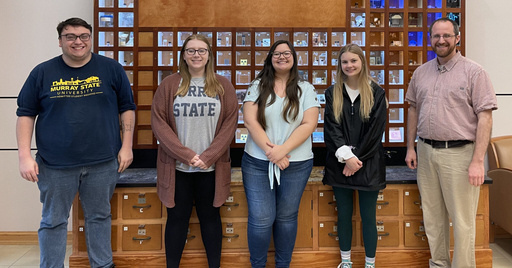Dr. Jonathan Lyon uses work from San Diego Supercomputer Center to present at the International Symposium on Small Particles and Inorganic Clusters
By Dani Ray | Nov 29, 2023

MURRAY, Ky. – Murray State University Assistant Professor of Chemistry Dr. Jonathan T. Lyon used his work with ACCESS allocations on Expanse at the San Diego Supercomputer Center (SDSC) at UC San Diego to present at the International Symposium on Small Particles and Inorganic Clusters (ISSPIC XXI) in Berlin, Germany, in September.
Entitled “Structures, Properties, and Reactivity of Doped Semiconductor and Transition Metal Clusters,” Lyon co-authored the presentation with several Murray State undergraduate chemistry students: Madison Winkeler, of Troy, Illinois; Ciara N. Richardson, of Beaver Dam, Kentucky; Ryan Carlin, of Louisville, Kentucky; and Joey Quilliam, of Henderson, Kentucky.
“The scope of the research projects in our group could not be as extensive without the ability to utilize the SDSC through these awarded National Science Foundation-ACCESS allocations,” said Lyon. “As Murray State does not have a high performance computing (HPC) cluster locally on campus for student and faculty use, the ability for our group to use these computing resources at SDSC greatly enhances the research and training we are able to perform. Undergraduate students are also introduced to these HPC resources, and taught how to use them in their formal coursework during laboratory assignments in the physical chemistry courses I teach at the University. The results from the cutting edge research we perform has not only led to further advancing the knowledge of atomic cluster science, but has also provided the groundwork training for recent graduates from our group to future their education in chemistry doctoral programs and obtain jobs in the chemical industry.”
Last year, Lyon published a chapter in an American Chemistry Society book titled “Physical Chemistry Research at Undergraduate Institutions.” His chapter, “Building Blocks: Investigating the Structures, Properties, and Reactivity of Strongly Bound Atomic Clusters at a PUI,” discussed his experience and findings using, in part, NSF-funded resources via the Extreme Science and Engineering Discovery Environment (XSEDE) and now ACCESS, NSF’s follow-on program.
Lyon said that one of his goals with undergraduate education at Murray State is to provide chemistry students with an understanding of structure-property relationships in strongly bound atomic clusters as size increases from individual atoms to bulk quantities. He said that this type of work models catalyst active sites and has the potential to help alleviate hazardous industrial conditions arising from the high pressures and temperatures required for the synthesis of some chemicals.
“We are both investigating new cluster structures and compositions not fully understood as well as hopefully motivating other scientists to build upon our work to larger real-world systems,” Lyon said. “Our specific research on the Expanse cluster at SDSC aims to discover new potential components for electrical devices and improve certain catalytic reactions.”
Lyon’s current work with his students focuses on the reactivity, structure and property of metal and semiconductor cluster systems. His research lab utilizes both experiments and simulations via Expanse.
“One of our current projects using ACCESS allocations at SDSC involves the role of weakly bound messenger atoms used in the experimental determination of metal cluster vibrational spectra,” he said. “Next, we will extend this work to explore hydrogen binding and reactivity with various metal cluster systems.”
To learn more about Murray State University’s Department of Chemistry, visit murraystate.edu/chemistry.
